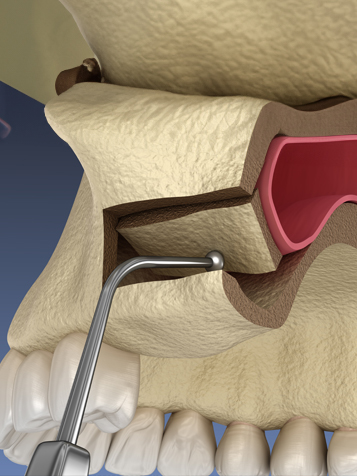What Are Sinuses?
The maxillary sinuses are the air-filled spaces in your upper jawbone (the maxilla). The maxillary sinuses lay behind your cheeks and on top of your upper teeth. Sometimes the roots of the upper natural teeth extend into the maxillary sinuses. When these upper teeth are removed, there is often just a thin bone wall separating the maxillary sinus and the mouth. A bone graft may also be necessary if the socket does not heal properly. In this case, there may be insufficient bone structure to support an implant without a bone graft augmentation.
What Is A Sinus Lift?
The term sinus lift comes from the technique used to increase upper jawbone volume. A sinus lift is a surgical procedure where a window is made into the sinus wall. The sinus membrane is then carefully lifted, and bone graft material is placed underneath the lifted sinus membrane. This increases both the height and width of the bone available for an implant. This procedure has been performed for over 35 years and has a very successful track record of creating sufficient bone structure to place dental implants.
What Is The Key To A Successful Sinus Lift?
A stable and long-lasting dental implant requires both quality and quantity of jawbone to integrate. If bone loss has occurred due to injury, tooth loss, or periodontal disease, sinus augmentation can create space for many different types of bone graft materials. This will allow bone formation.
A sinus lift is one of the most common bone grafting procedures for patients with an insufficient amount of bone in the upper jaw. A sinus lift procedure seeks to grow bone in the maxillary sinus floor above the bony ridge of the gum line. This helps anchor the teeth in the maxilla.
The key to a successful sinus lift bone graft is good pre-operative planning, utilizing a cone beam CT radiograph, establishing the appropriate diagnosis, and then meticulously performing the procedure. When all these factors are met, it allows us to successfully place and secure dental implants in the area where your upper tooth has been lost.
How Do Sinus Lifts Work?
Sinus augmentation is not a difficult surgical procedure, but it requires meticulous surgical technique. Most patients choose to be asleep for the procedure, but it can be done under local anesthesia.
A small incision is made in the premolar or molar region to expose the jawbone. A small window opening is made in the bone, and the sinus membrane is lifted upward. The space under the membrane is packed with bone grafting material. The bone grafting materials used for sinus lifts are allogenic bone grafts (grafts derived from human donor bone), or in some cases xenografts (grafts derived from an animal source), or collagen and calcium phosphate mineral sources.
Most patients who undergo a sinus lift bone graft have minimal postoperative pain and swelling. After several months of healing, the bone becomes an integral part of the patient’s upper jaw. After a CBCT evaluation and virtual implant planning session, we can insert dental implants into the newly formed sinus bone.
If initially there is enough bone between the upper jaw ridge and the bottom of the sinus to stabilize the implant sufficiently, sinus augmentation and implant placement can sometimes be performed as a single procedure. This technique shortens treatment time.
If there is not enough bone available, sinus augmentation will have to be performed first. The graft will mature for several months, depending upon the type of graft material used. Once the graft matures, implants can be placed.
Who Is A Candidate For A Sinus Lift?
A sinus lift may be necessary if you:
- Are missing one or more teeth in the back of your upper jaw
- Are missing a significant amount of bone in the back of your upper jaw
- Are missing teeth due to a congenital disability, periodontal disease ,or in patients with small facial features
- Upper teeth that have been missing for quite some time and the patient requires dental implant support


